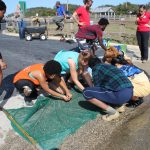The 4DEE Framework
Learn more about 4DEE
For 4DEE activities, please visit the Current Activities page
The Four Dimensional Ecology Education (4DEE) Framework
Updated October 2024 | Download Summary Paper [docx]
I. Core Ecological Concepts
The list below covers an array of concepts critical to understanding ecology. It is based, in large part, on the material presented in introductory ecology textbooks and thus, represents an inventory of core ecology concepts recognized a large number of authors (historical and current; see for instance almost every edition of Begon et al., Krebs, Molles, Odum, Ricklefs, Smith & Smith, etc). These concepts are used by many of us to construct our syllabi, to test student learning, and to shape our degree programs. This list of concepts is divided into seven groups. Within each group is a set of related concepts, e.g. trophic levels, predation, food chain/web, energy flow, nutrient cycling, regulators.
- Organisms
- Populations
- Communities
- Ecosystems
- Landscapes
- Biomes
- Biosphere
II. Ecology Practices (EP)
This list of practices elucidates the basic components associated with the scientific process, e.g. making observations, collecting data, and generating and testing hypotheses (Moore 1993). It represents an essential description of approaches and skills used in and necessary for doing science, with particular attention to how ecological science is conducted. Clearly, many of these practices reflect general approaches used in most scientific disciplines (Brewer and Smith 2011, Table 2.1; NRC 2013) with some components unique to ecology.
- Natural history
- Fieldwork
- Quantitative reasoning and computational thinking
- Data analysis and interpretation
- Designing and critiquing investigations
- Working collaboratively
- Communicating and applying ecology
III. Human-Environment Interactions (HEI)
All of us acknowledge that every place on earth is impacted to some degree by humans (see Commoner 1971). The connections between humans and the environment were a unifying theme of ESA’s Sustainable Biosphere report (Lubchenco et al. 1991). In 2000, Crutzen and Stoermer suggested that the human effect on the environment was sufficiently significant as to constitute a new geological epoch, the Anthropocene. Recognizing this, Palmer et al. (2005) noted a “need to refocus the discipline towards research that ensures a future in which natural systems and the humans they include coexist…” and further, that “…ecologists must play a greatly expanded role in communicating their research and influencing policy and decisions that affect the environment.” Over 1000 ESA members responded to the 2007 Vice Presidents’ Survey on Ecological Literacy, and nearly half of the essential elements of ecological literacy mentioned were related to human/environment interactions (McBride 2011). More recently, Lubchenco (2017) pointed to the need for greater engagement by scientists in addressing societal problems, e.g. “We must engage more vigorously with society to address the intertwined environmental and social problems that many have ignored, to find solutions, and to help create a better world.” To that end, educational efforts must ensure that ecology students- and even the discipline itself – attend to the interaction between humans and the environment.
The ideas listed here emphasize that bi-directional interrelationship between humans and the Earth’s biota and physical environment, with particular attention to the normative values underlying decision-making and policy (Collins et al. 2011, Jablonski, et al. 2015). Incorporating the human-environment interactions into the 4DEE framework recognizes that every place is shaped by humans and every human need is shaped by the environment. In order to address and solve today’s problems, this understanding is necessary–and critical.
- Human interdependence on the environment
- Human impacts on the environment from local to global scales
- Ecological Ethics
IV. Cross-Cutting Themes (CCT)
Many ecologically-related ideas and approaches do not fall neatly along the other three dimensions – interactions, practices, and especially the hierarchy of core concepts. Some interrelate to other areas of science, while others, although ecologically related, place different demands in how they are studied. Vision and Change in Undergraduate Biology Education (Brewer and Smith 2011) recommended that “all undergraduates need to understand” evolution, pathways, and transformations of energy and matter, information flow, exchange, and storage, structure and function, and systems. Here, we focus on five elements that are often thought of as approaches or ways of thinking: pathways and transformations of matter and energy, structure and function, systems, and space and time.
- Structure & Function
- Pathways & Transformations of Matter and Energy
- Systems
- Evolution
- Space & Time



